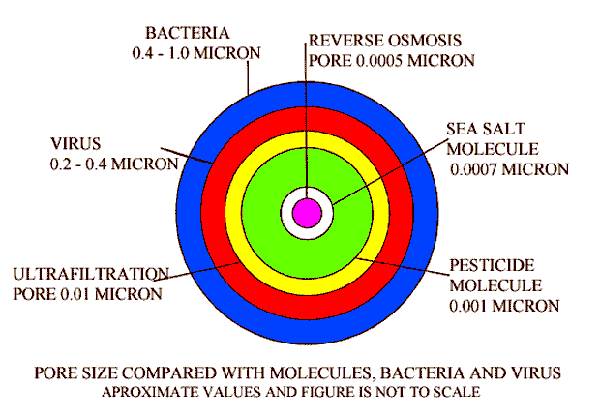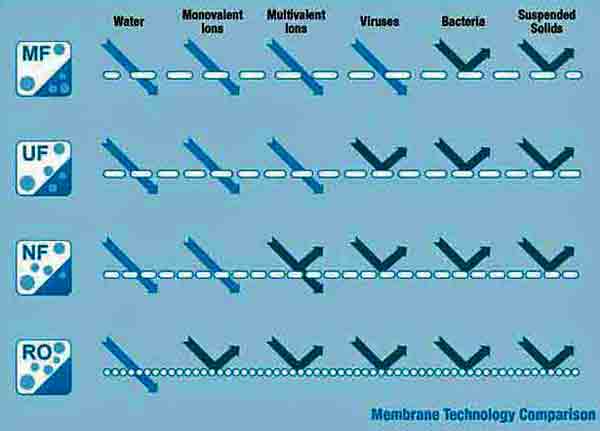What means membrane in water purifier
Membranes are very thin sheets of a synthetic plastic material which have very fine holes or pores. The size of pores are different in different kinds of membranes used in water filters. Membranes used in water filters are classified according to the pore size of membranes as: Micro-filtration membranes MF, Ultra-filtration membranes UF, Nano-filtration membranes NF and Reverse Osmosis RO membranes.
The types of membranes used in Reverse Osmosis RO water purifiers have the smallest pores and their pores are so small that it is just a little larger than the size of a water molecule and so it will allow pure water molecules to pass through easily, but will stop the passage of larger molecules of salts and organic chemicals.
The figure below is a graphical representation of the pore sizes of different types of membranes used to purify water and how the pore sizes of types of membranes compares with the size of salt molecules, Viruses, etc.

From the membrane pore size diagram above of types of membranes used to purify water, we can visualize and understand the relative pore size of RO Membranes and the sizes of common water impurities. This helps us to understand how an RO water purifier works. The pore size of RO membrane is 0.0005 microns which is smaller than the size of the Sodium Chloride Molecule which is 0.0007 micron and will not let it through. Nor will it let through germs and viruses, and organic molecules which are very much larger than the RO pore.
Types of membranes used to purify water, Why are membranes used in water purification
Membranes are the best filtration media for water. Membranes used for water purification can have their pore size so designed to give the best efficiency for the job in hand. For example to purifyriver water it is not neccessary to have very small pores like an RO membrane which requires high pressure and thus need a lot of energy to work. So for water with low content of salts like river water you need to remove only the germs and dirt in the water, so the ideal membrane for such an application would be the UF membrane which use very little energy and will filter out the smallest of viruses and dirt particles. The river water that comes out of a UF membrane is clean and safe to drink.
When there are salts in the water, like in seawater, then an RO membrane will be required to purify the water. So an RO membrane will purify water from almost all chemicals. What can pass through the RO membrane is water and molecules smaller than the water molecule, like CO2 gas. Smaller molecules than water is generally not harmful to health. The RO Water is very pure almost distilled water in quality. Bottled water manufacturers usually use Reverse Osmosis Water Filters to purify their water.
Membrane filters for water treatment
The diagram below is again a graphical representation of what can pass through the different types of membranes.

Membrane Water Purification is the best water purification Technology available today. Membrane water purifiers are much better than water purifiers using chemicals and UV. We explain below each of the different types of membrane as shown in the above diagram
What is MF Membrane
MF stands for MicroFiltration. MF Membrane has average pore size of 0.1 microns. Pore size can vary from 0.05 micron to 5 micron. MF membrane is good for removing water borne parasites like protozoa like, Cryptosporidium and Giardia, but is not good for removal of bacteria and viruses. MF or Microfiltration is mostly used in the food industry for processing fruit juices and milk products.
What is meaning of UF Membrane
UF stands for UltraFilter. UF membranes are the next higher pore size membrane which has a pore size average of 0.02 micron and can vary from 0.001 micron to 0.05 micron. UF membranes will not allow any bacteria, viruses, parasites nor any microbe to pass through. Thus an ultra-filter membrane water purifier is very useful in situations where you have good water but have to guard yourself against germs. An ultra-filter water purifier is better than an UV water filter because a UF water purifier actually removes all germs and microbes from the drinking water using only normal tap water pressure. UV on the other hand kills the germs and leaves their dead or inactivated bodies in the water. We have a dedicated page on UF water purification
What is meaning of NF Membrane
NF stands for Nanofilter. NF Membrane has a pore size at an average of 0.001 microns and may vary from 0.008 micron to 0.01 micron. It is slightly larger than the RO pore size (0.0005 microns) and slightly larger than the size of common salt (NaCl) molecule. So NF membrane allows monovalent common salt Sodium Chloride to pass through but will not allow divalent Calcium salts like Calcium Carbonate of diameter 0.0009 microns to pass through. Since NF membrane removes hardness from water, one of NF membranes most important application is in water softening. NF membranes are also very efficient to purify water of heavy metal salts like Arsenic, Lead, Cadmium and Mercury and at the same time it removes all germs and viruses from water. We have a dedicated page on Nano filtration water purification
What is meaning of RO Membrane
RO stands for Reverse Osmosis. RO membranes have the smallest pore size of about 0.0005microns. This is just slightly larger than the size of a water molecule but smaller than the size of a Sodium Chloride Molecule at 0.0007 micron. So Sodium Chloride and all salts are blocked and only pure water flows through the RO membrane. Thus one of the main applications of RO membranes is in seawater desalination, by which sea water is purified to get fresh drinking water. We have a dedicated page on Reverse Osmosis water purification
Best way to buy Water Purifiers in India
The best way to buy Water Purifiers in India is to first look at all models of Water Purifiers available online at the leading online Retailers in India. For example on the online webpage of All Water Purifiers available in India on Amazon.in, you will find the full range of Indian Water Purifiers complete with their best discounted price and full specifications. This is great information, and you can decide on which model of water purifier to buy. With the model of water purifier you want to buy finalised, you can go to local shops to try and find the model of water purifier you have chosen and see if you can get at similar price of that at Amazon.in. In most cases the price from Amazon will be cheaper, because they buy in bulk from the manufacturers direct and they sell huge volumes because they are the world's largest and most trusted online retailer. If you buy from Amazon, they will arrange to have the water purifier installed in your house, usually free of charge.
Warranty and other facilities offered through Amazon are usually better than what you can get from local agents of water purifiers.
All pages in our website www.AchaWater.com
Below are links to all the pages on this website and we hope you will make full use of all the great information about Indian Water Purifiers provided here.